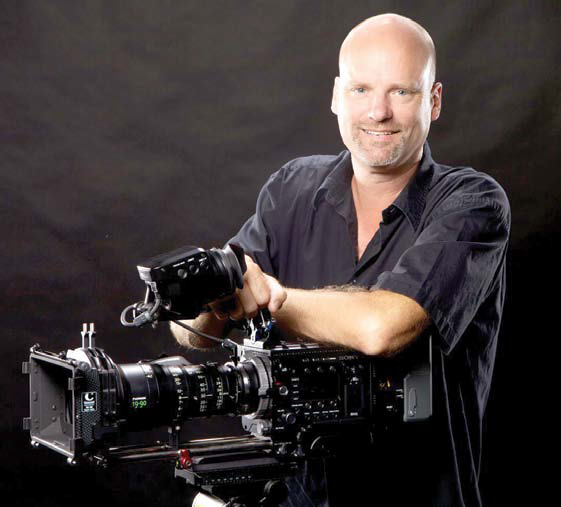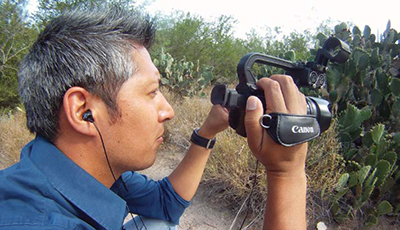When the Light Hits the Lens

Jon Nelson, owner of Production Hero in Orange County, Calif., recently paired a new Fujinon Cabrio Premier PL Mount cinema-style zoom lens with a Sony PMW-F55 CineAlta 4K digital cinema camera.
NEW YORK—Steady advancement in image capturing electronics makes lenses and lens electronics selection more critical in the image gathering process than ever before.
Some broadcasters adding or replacing cameras are beginning to move away from the standard 2/3-inch lens that was the center of the broadcast video camera universe for decades. While this market segment remains strong, the market for broadcast lenses and cameras is evolving in two directions simultaneously.
CINE-STYLE AND 4K
According to Larry Thorpe, senior fellow at Canon U.S.A., Inc., one direction is “smaller, lighter, less expensive camera electronics packages.” Those who purchase this new generation of less expensive cameras often prefer a less expensive lens as well. The other direction is high-end, such as 4K, professional sports and cine-style production applications.
Most TV news photographers and videographers know that one camera and lens does not fit all uses. At the network level, many ENG shooters still carry two lenses, one for wide angle work, and another for telephoto shots and broadcast lens manufacturers have responded with single lenses that meet both needs; Canon’s HJ17ex6.2B Series, Fujinon’s HA14x4.5BERD and Angenieux’s 19 x 7.3 HD Video Lens all provide a single ENG lens solution.
Many news organizations prefer shooting long-form news magazine type programming cine-style, with tighter control of creative variables such as depth-of-field. Some news magazine shows are shot with smaller cameras such as Canon’s EOS C300; others are being captured in 4K. Viewer interest in 4K may be in its infancy, but broadcasters are discovering distinct advantages in cine-style production of commercials and promos.
“One of the challenges of 4K is the sizes of image sensors,” said Thom Calabro, director, marketing and product development for Fujifilm North America Optical Devices Division. For example, the Red Epic is 31.4 mm diagonally while Sony’s F65 is 27.9 mm and the ARRI Alexa is 27.2 mm. All use a PL mount. The PL mount, new to most broadcasters entering 4K production, was invented by ARRI in the late 1970s to support the Super 35mm film format. Fujinon’s Cabrio lenses use a PL mount while Canon Cinema lenses can be ordered with either PL or EF mounts. Canon introduced the electronic focus mount in 1987 for its EOS line of SLR film and digital cameras. The EF mount remains relevant due to the high number of EF lenses many still photographers converting to video already own.
Get the TV Tech Newsletter
The professional video industry's #1 source for news, trends and product and tech information. Sign up below.

KRGV-TV news photographer Mike Ortiz using the Canon XA10 professional HD camcorder on location for the Lone Star Emmy-winning report, "The Battle in Brooks County." Calabro warns that “one challenge with PL mounts is the relatively large size of cameras using them.” There is a market that needs functions best suited for over the shoulder and pedestal mounted cameras, and there is also a trend towards smaller and lighter 4K cameras using smaller image sensors. However, the size of pixels on smaller sensors is a tradeoff. “The problem,” Calabro says, “is getting enough light to the sensor. Smaller pixels don’t hold as much light.”
GETTING IT RIGHT VS. GETTING IT FAST
The differences between broadcast, professional, and remote lenses boil down to their specific application. “Broadcast lenses are designed for ENG crews shooting under high pressure,” Thorpe said.
In addition to being more rugged, the electronics have been refined by design as well. Canon’s broadcast lenses use 16-bit servos for tight precision and programmable recall. Broadcast lenses with digital servos also provide a flawless digital interface for virtual sets, robotics and sports events. Lower-cost lenses that use analog servos don’t provide the digital interface and are also generally less rugged than their broadcast counterparts.
Remote lenses have become increasingly popular for remote pan-tilt-zoom applications. Because they are designed to be mounted on a camera that is permanently installed, indoor remote lenses are not necessarily designed for rough treatment. On the other hand, outdoor lens applications such as weather, traffic cams and sports applications must be able to withstand the elements and extremes. Weatherproofing makes outdoor remote lenses unique.
RUN AND GUN
Until about a decade ago, all broadcast cameras required an optional lens—that changed when Panasonic introduced the AG-DVX100 featuring a high-quality built-in lens. Most news shooters appreciate the defensive weapon potential of traditional over-the-shoulder broadcast cameras, but many are also gaining an appreciation of a new generation of feature-rich smaller HD cameras. Some have permanent built-in lenses while others offer lens options including still photography and prime lenses. Some camera and lens combinations provide the shallow depth of field that creates what some call the “cine look.”
Nearly everyone agrees smaller cameras provide new creative freedoms and allow more interesting angles and shots than larger cameras. They also generally cost less than traditional ENG cameras, which allows news departments to put more HD cameras on the streets.
“Broadcasters want more ‘run-and-gun’ for all sorts of ENG,” Thorpe said.
The infrared feature of a small Canon XA10 helped KRGV-TV in Weslaco, Texas capture memorable nighttime video that was awarded a Regional Emmy. KRGV photographer Mike Ortiz, who captured footage of illegal immigrants crossing the border at night, said the shoot included “interviews with volunteers who patrol the ranchlands in the dark looking for lost illegal immigrants. The XA10 is small, versatile, non-intimidating, and it gives us great video. That’s what I need in my line of work.”
